IGCSE Physics Past Years Exam Questions: Electricity 2023-24
We analysed the International GCSE past papers and grouped the questions by topic. Here, you will find questions relating to the topic – Electricity. Use these to familiarise, practice and prepare for your IGCSE Physics examination.
For other past years exam questions on electricity see below:
What you need to know
Use the list below as a quick recap for what you need to know before attempting the past year exam questions under this topic. This is based on Edexcel International GCSE in Physics (4PH1) specification with first teaching Sept 2017 and first examination June 2019.
Paper 1 and 2: (2) Electricity
Paper 1 covers the Electricity topics below except “Electric charge” while paper 2 covers all Electricity topics.
A. Units
- electrical units: ampere (A), coulomb (C), joule (J), ohm (Ω), second (s), volt (V) and watt (W).
B. Mains electricity
- use of insulation, earthing, fuses and circuit breakers.
- why current in a resistor results in transfer of energy and increase in temperature.
- power = current x voltage. P=I×V
- energy transferred = current x voltage x time. E=I×Vxt
- the difference between alternating (ac) and direct currents (dc).
- explain the use of parallel and series circuits
C. Energy and voltage in circuits
- how the current in a series circuit depends on the applied voltage and the nature of components in the circuit.
- describe and investigate how current varies with voltage in wires, resistors, filament lamps and diodes.
- describe the qualitative effect on current of changing the resistance in the circuit.
- describe the variation of light-dependent resistors with light intensity
- and thermistors with temperature.
- lamps and LEDs show the presence of a current in a circuit.
- voltage = current x resistance. V=I×R
- current is the rate of flow of charge
- current = current x time. Q=I×t
- electric current in solid metallic conductors is a flow of negatively charged electrons
- why current is conserved at a junction
- voltage across two components in parallel is the same
- calculate the currents, voltages and resistances of two resistive components connected in a series circuit
- voltage is the energy transferred per unit charge (joule per coulomb)
- energy transferred = charge x voltage. E=Q×V
D. Electric charge (paper 2 only)
- identify common materials that are insulators and conductors (metals and plastics)
- practical: how insulating materials can be charge by friction
- explain the charging of materials by the loss (+ve electrostatic charge) or gain of electrons (-ve electrostatic charge)
- that there are attractive forces between unlike charges and repulsive forces between like charges
- explain the potential dangers of electrostatic charges (fuelling aircraft and tankers)
- explain some uses of electrostatic charges (photocopiers and inkjet printers)
January 2023 Paper 1P Q7
7 A student uses the circuit shown in diagram 1 to investigate how the current changes with voltage for a filament lamp.
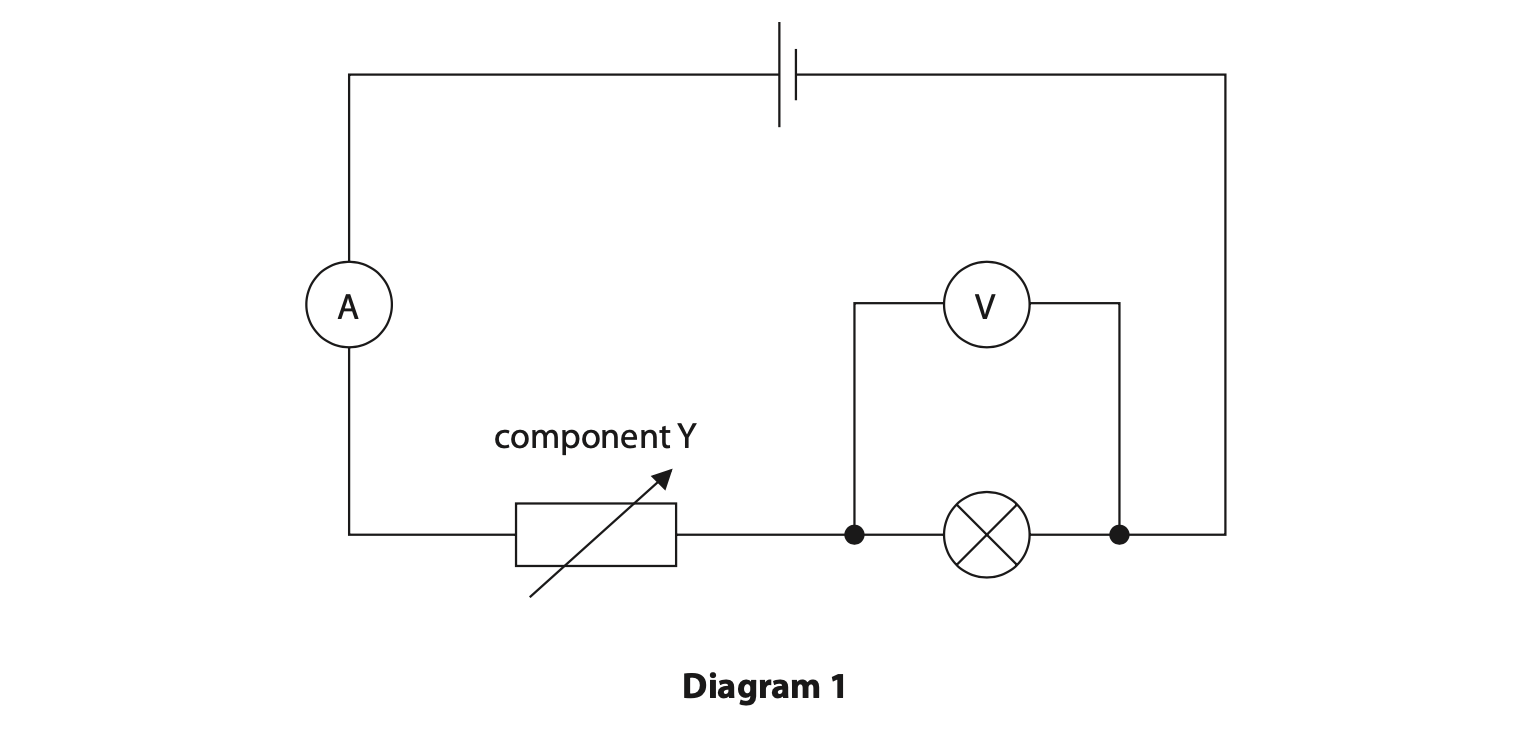
(a) (i) Give the name of component Y. (1)
(ii) Give a reason why component Y is included in the circuit. (1)
(b) The graph shows some of the student’s results.
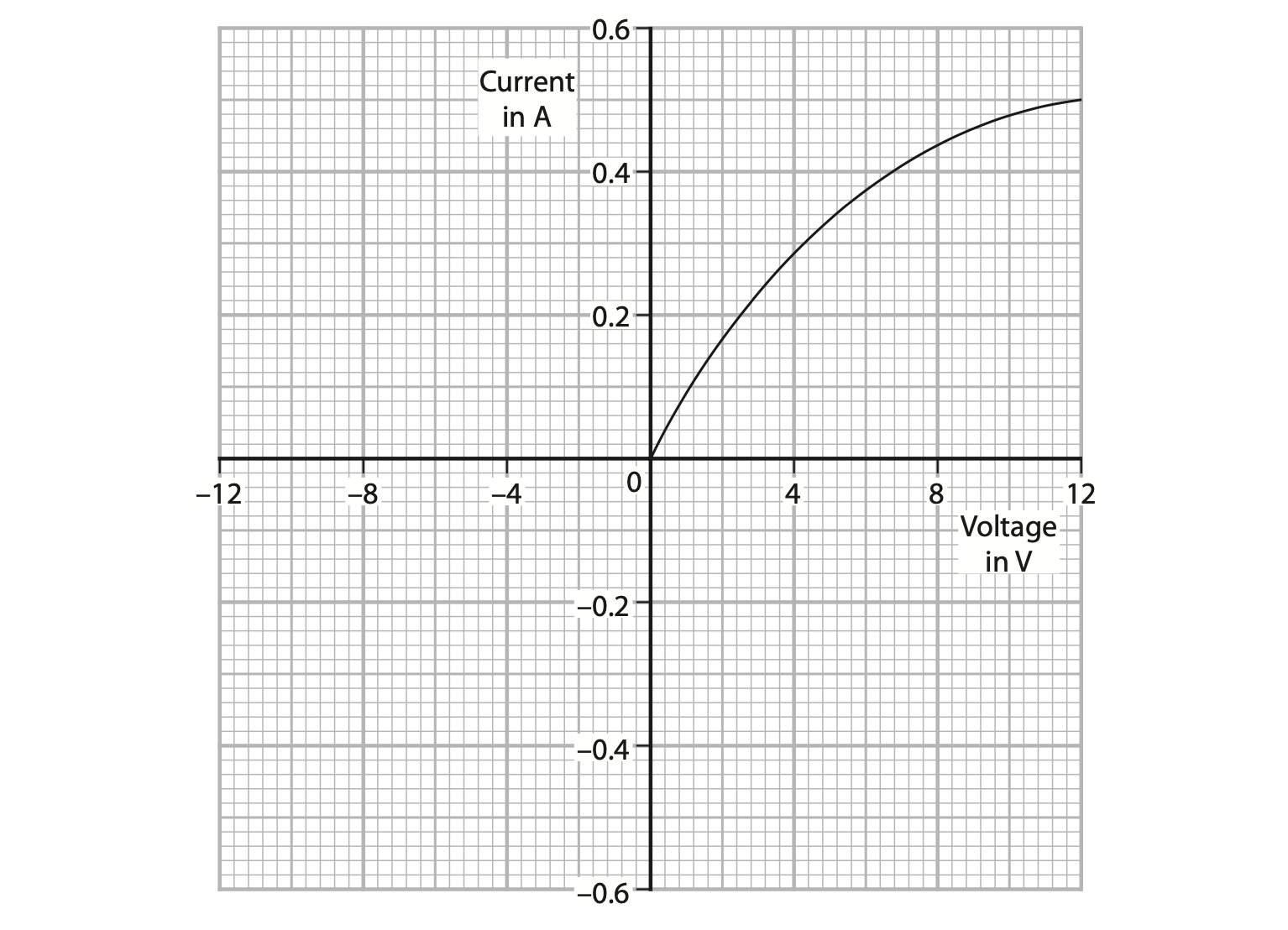
(i) State the formula linking charge, current and time. (1)
(ii) Determine the current in the lamp when the voltage across the lamp is 10V. (1)
current = …………………………………………………….. A
(iii) Calculate the charge transferred through the lamp in 30 s when the voltage across the lamp is 10V.
Give the unit. (3)
charge = …………………………………………………….. unit ……………………………………………………..
(iv) Calculate the time for the lamp to transfer 250 J of energy when the voltage across the lamp is 10V. (3)
time = …………………………………………………….. s
(v) The student disconnects the cell and reconnects it with its terminals reversed.
Complete the graph to show how the current in the lamp varies with voltage across the lamp when the cell is connected with its terminals reversed. (2)
(c) The student replaces the filament lamp with a light emitting diode (LED) and replaces the cell with an alternating current (a.c.) power supply, as shown in diagram 2.
The student also removes the ammeter and voltmeter from the circuit.
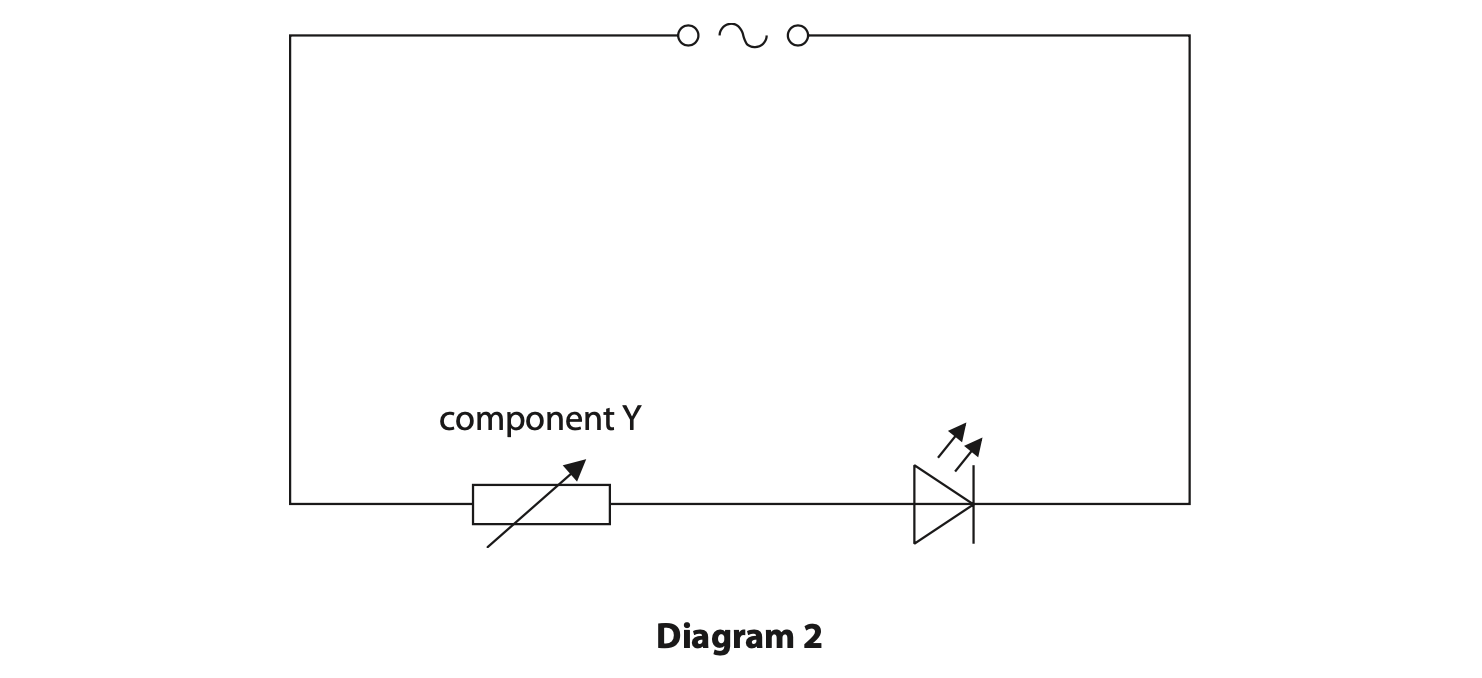
Explain why the LED flashes on and off in this circuit. (2)
(Total for Question 7 = 14 marks)
January 2023 Paper 1PR Q4
4 A student investigates how the current in a filament lamp varies with the voltage across it.
The student has this equipment
- filament lamp
- cell
- variable resistor
- ammeter
- voltmeter
- connecting wires
(a) Draw a circuit diagram that the student could use for this investigation. (4)
(b) The table gives the student’s results.
| Voltage in V | Current in A |
| 0.0 | 0.0 |
| 1.0 | 0.38 |
| 2.0 | 0.61 |
| 3.0 | 0.80 |
| 4.0 | 0.90 |
| 5.0 | 0.96 |
| 6.0 | 1.00 |
(i) Plot the results on the grid. (1)
(ii) Draw the curve of best fit. (1)
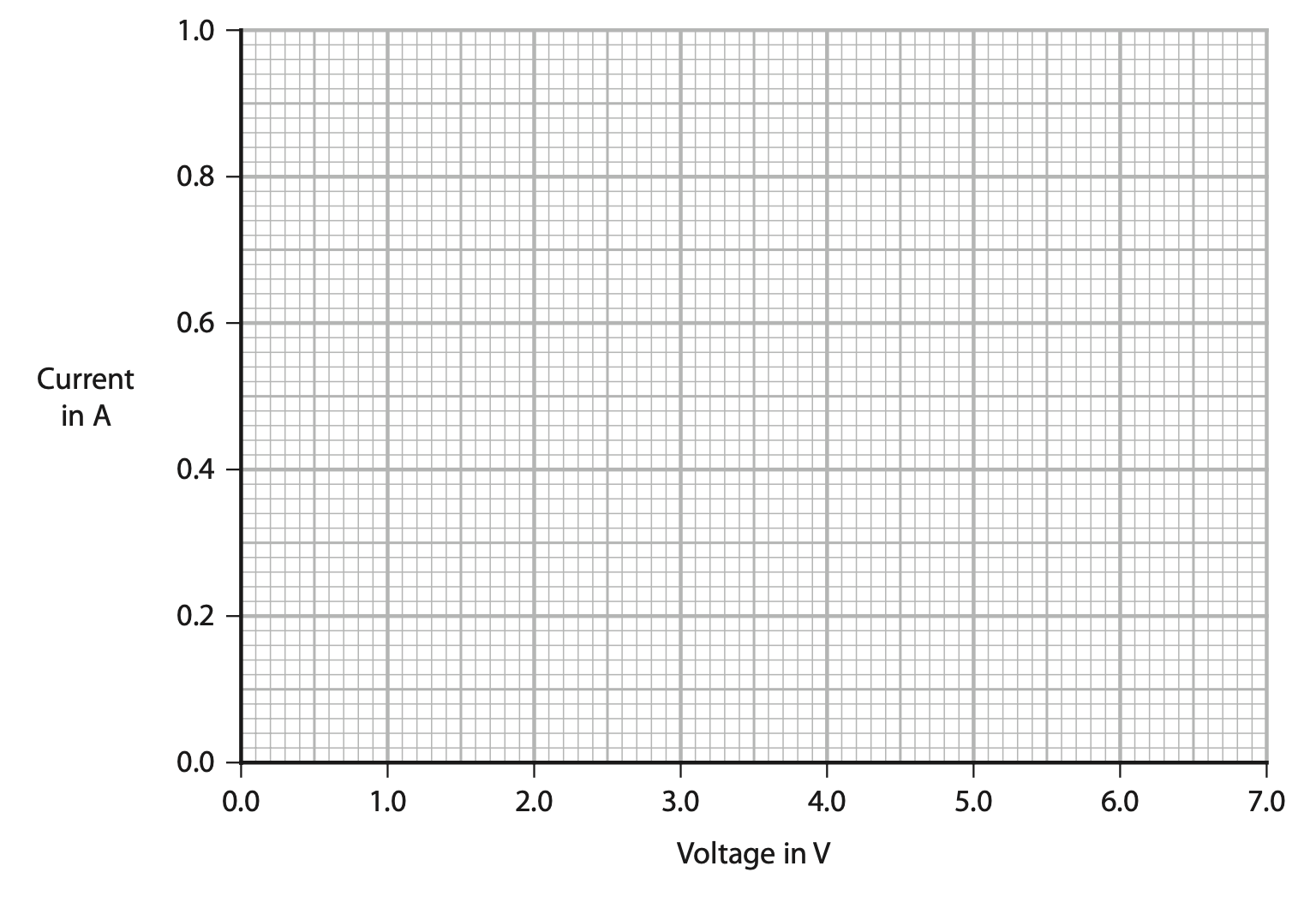
(c) The filament of the lamp is made of metal.
The student suggests that a straight line on the graph is more appropriate than a curve because current is directly proportional to voltage for a metal.
(i) Suggest how the student could improve their investigation to find out whether a straight line or curve is more appropriate. (1)
(ii) Explain why the student should not expect current to be proportional to voltage for this filament lamp. (2)
(Total for Question 4 = 9 marks)
January 2023 Paper 2PR Q4
Diagram 1 shows a circuit built by a student.
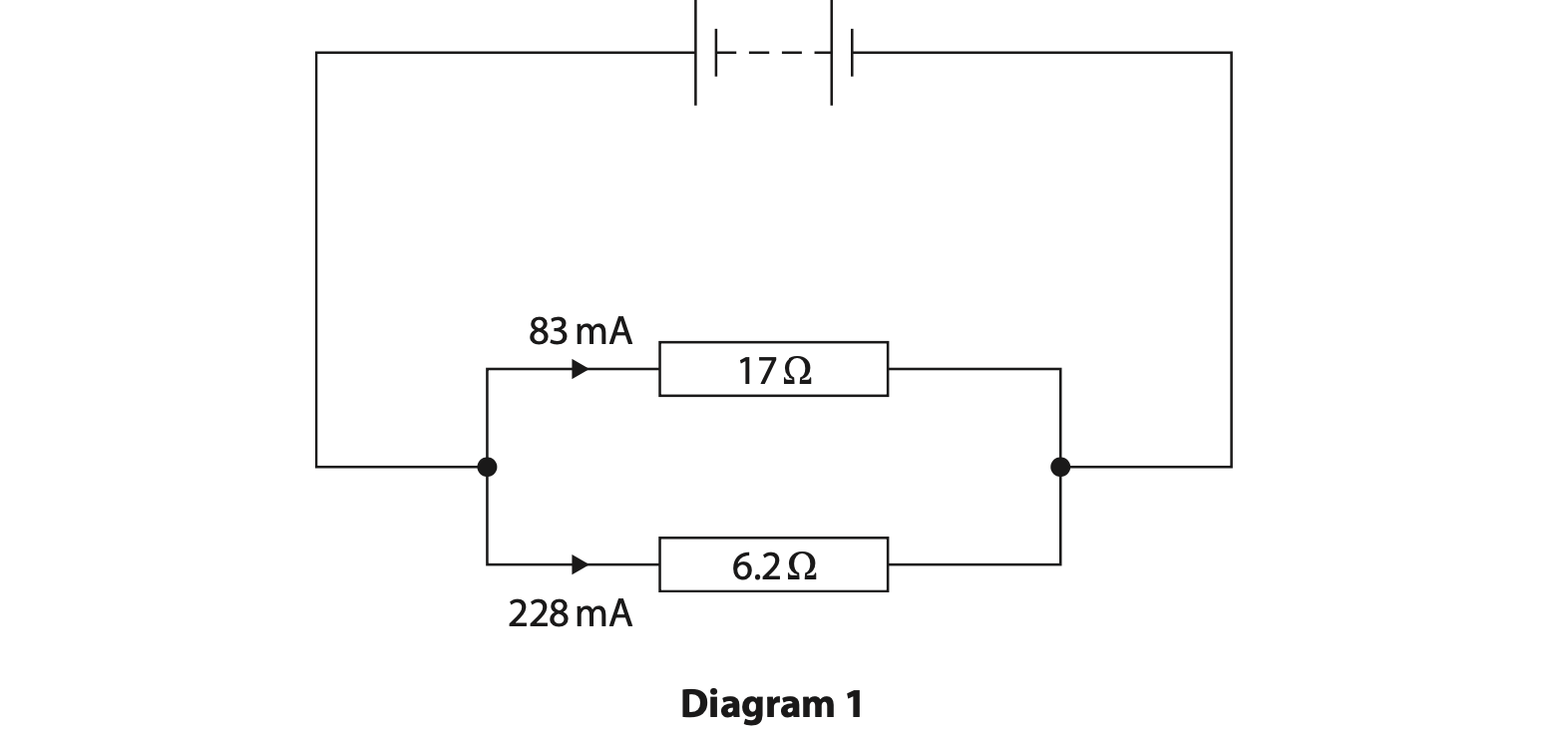
(a)(i) State the formula linking voltage, current and resistance. (1)
(ii) Calculate the voltage across the 17 Ω resistor. (3)
voltage = …………………………………………………….. V
(iii) State the voltage across the 6.2 Ω resistor. (1)
voltage = …………………………………………………….. V
(iv) Calculate the current in the battery. (2)
current = …………………………………………………….. mA
(b) Diagram 2 shows a second circuit built by the student using the same battery and resistors.
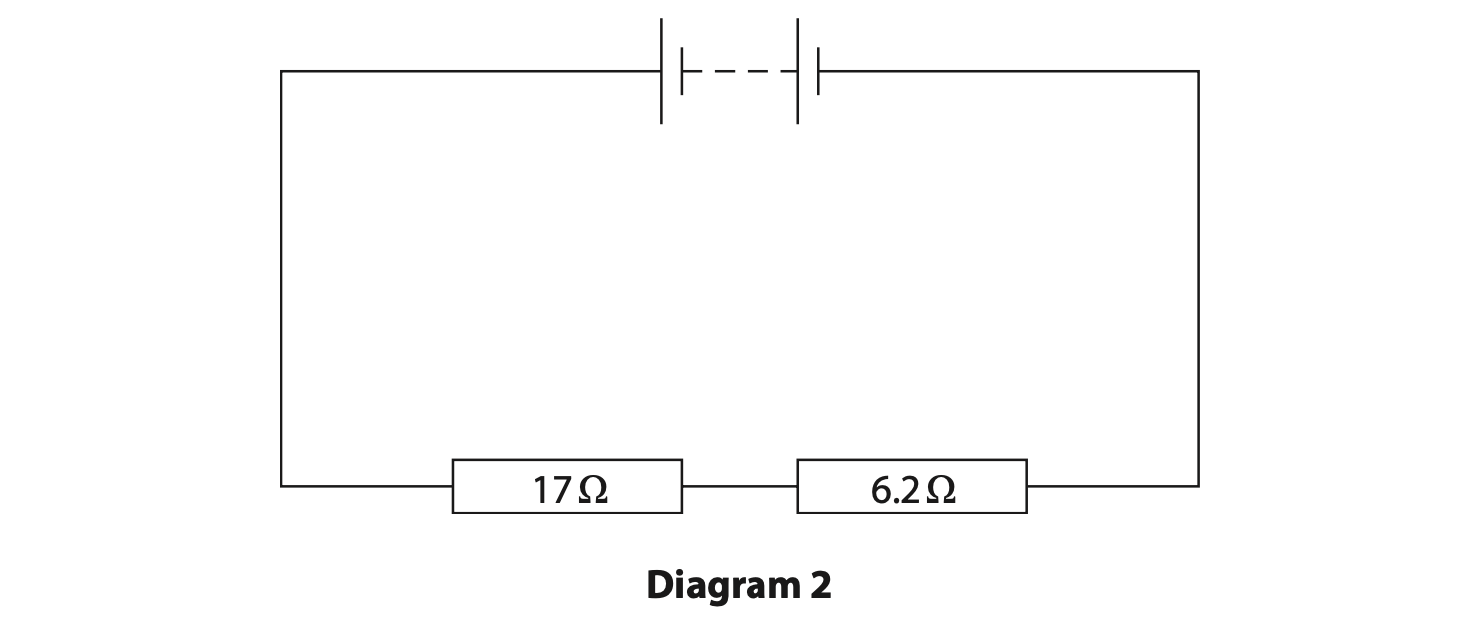
Explain how the current in the battery will change now the resistors are connected in series.
You do not need to do any calculations in your answer. (3)
(Total for Question 4 = 10 marks)
June 23 Paper 1P Q2
Topic: Investigating a filament lamp
2. A student investigates how the current in a filament lamp changes when the voltage across the lamp is varied.
(a) Draw a circuit diagram the student could use in their investigation. (4)
(b) The graph shows the student’s results.
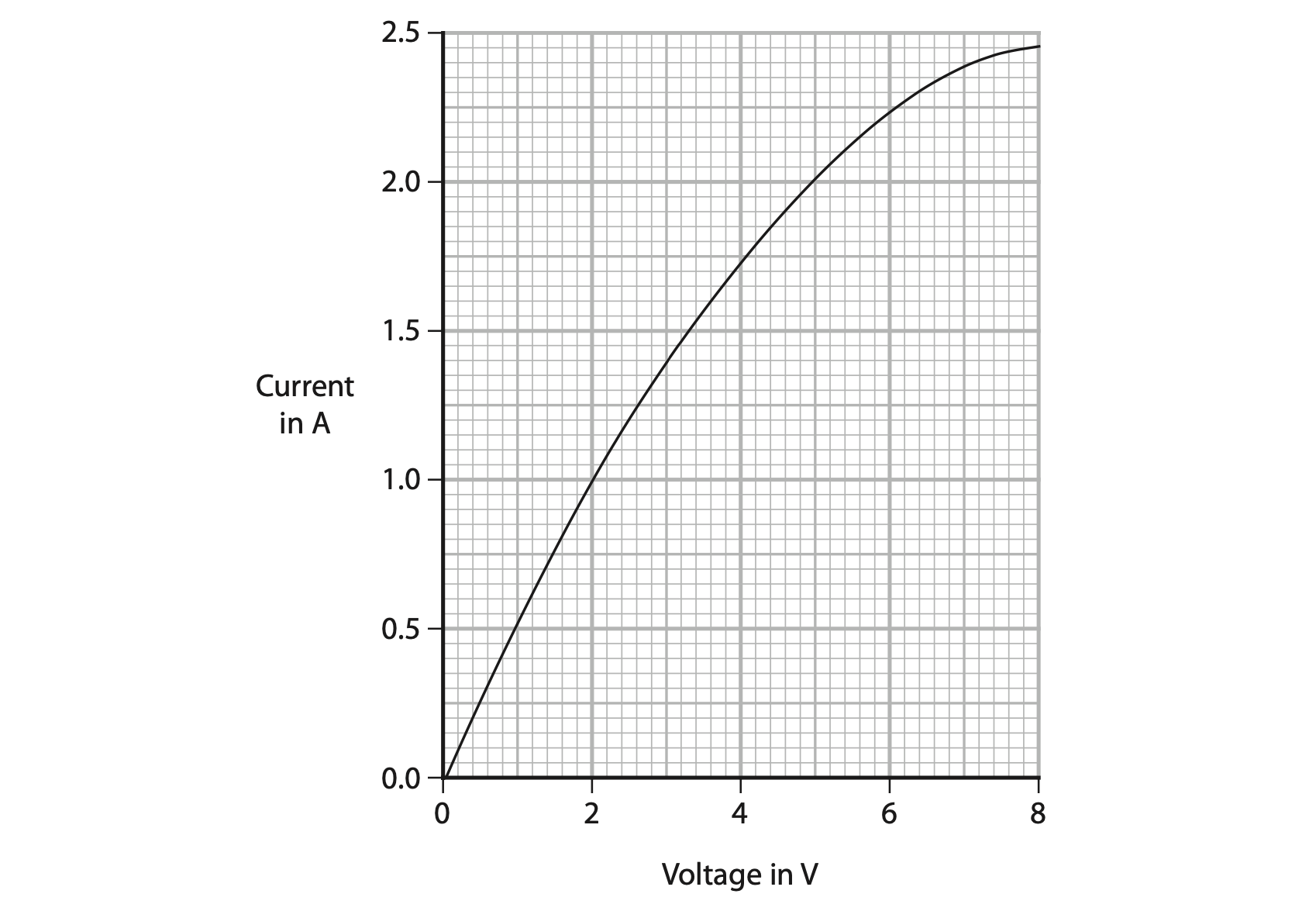
(i) Describe the relationship between current and voltage shown on the graph. (2)
(ii) State the formula linking resistance, voltage and current. (1)
(iii) Use the graph to determine the resistance of the filament lamp when the voltage across the lamp is 7.2 V. (3)
resistance = …………………………………………………….. Ω
(Total for Question 2 = 10 marks)
June 23 Paper 1P Q7
7. The circuit diagram shows a motor, power supply, switch and variable resistor connected in series.

(a) The switch is open and the motor is not moving.
State how much energy is in the kinetic energy store of the motor. (1)
kinetic energy = …………………………………………………….. J
(b) The switch is closed.
The motor takes 0.42 seconds to reach its maximum speed of rotation.
The mean current in the motor is 3.9 A.
The voltage across the motor is 7.1 V.
Show that the work done on the motor during the 0.42 seconds is about 12 J. (2)
work done = …………………………………………………….. J
(c) Complete the Sankey diagram for the electric motor during the 0.42 seconds by giving the missing information. (3)
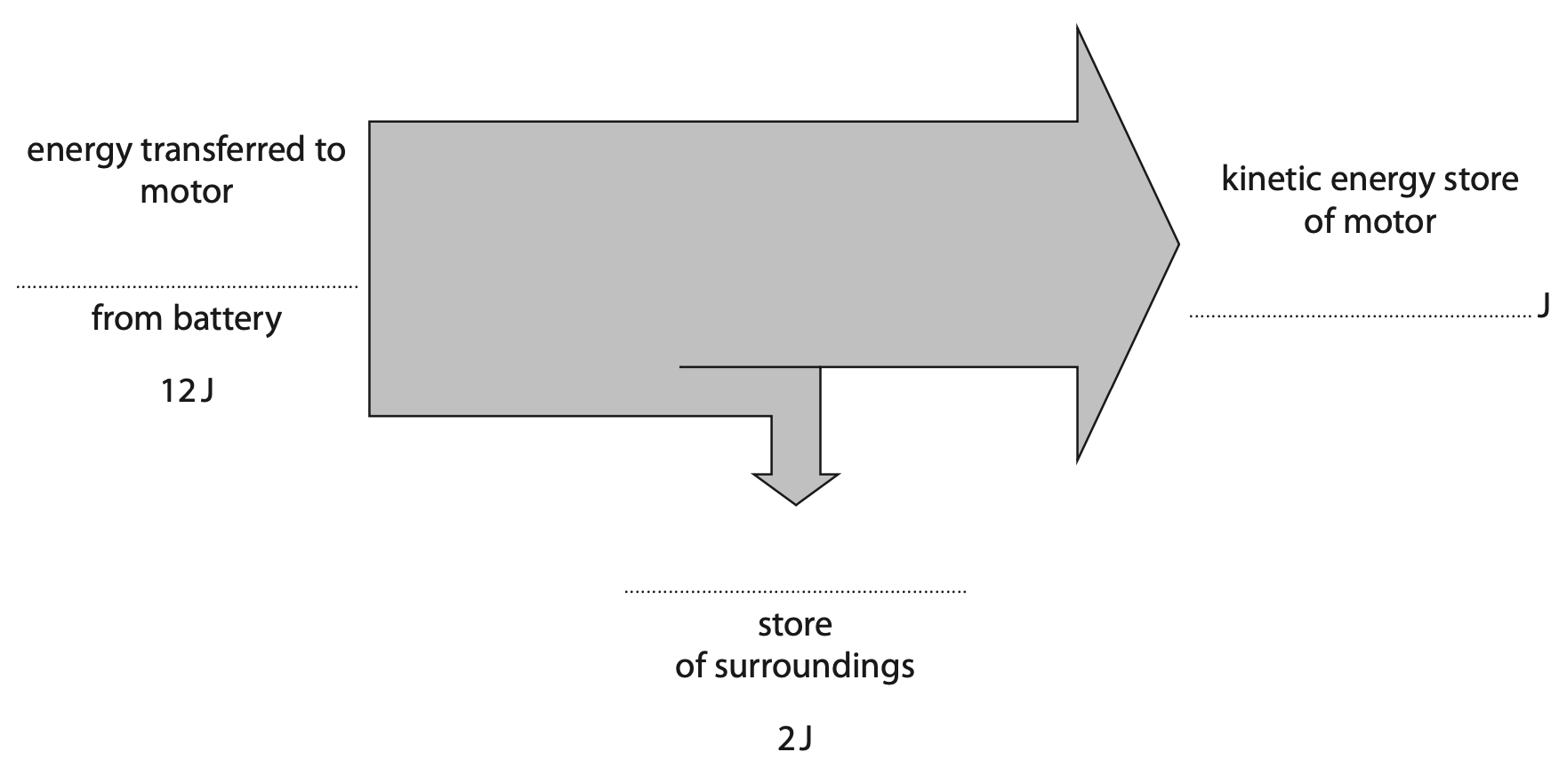
(d) Use the Sankey diagram to calculate the efficiency of the process of bringing the motor to its maximum speed of rotation. (3)
efficiency = …………………………………………………….. %
(Total for Question 7 = 9 marks)
June 23 Paper 1P Q11
11. Diagram 1 shows a light-emitting diode (LED) and a resistor in series with a cell and an ammeter.
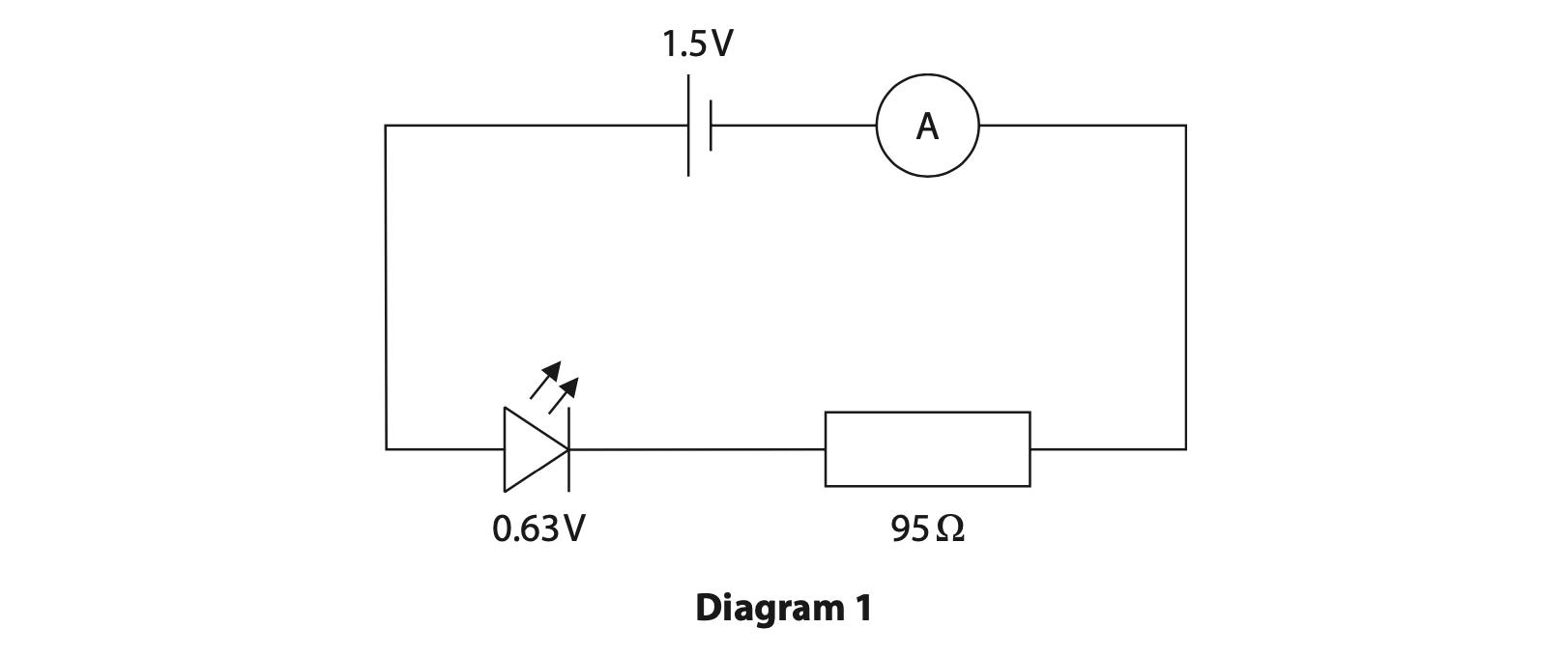
(a) The voltage across the LED is 0.63V.
Calculate the current in the circuit.
Give your answer in milliamps. (4)
current = …………………………………………………….. mA
(b) Diagram 2 shows a second LED and an extra resistor connected in parallel with the cell.
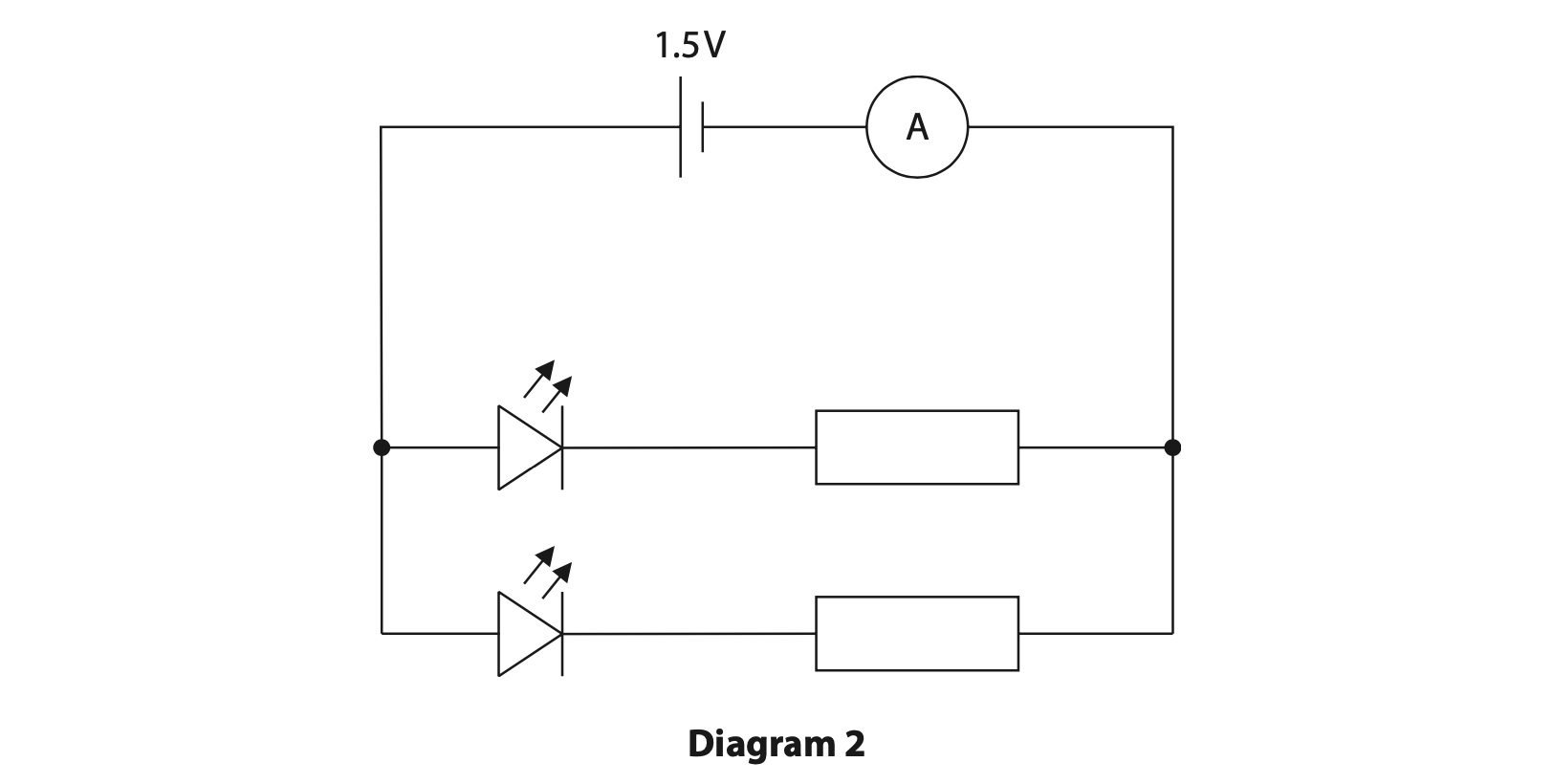
The resistor and the LED are the same as the components used in diagram 1. The two resistors are identical and the two LEDs are identical.
Explain how the ammeter reading will change. (4)
(Total for Question 11 = 8 marks)
June 23 Paper 1PR Q6
Question 6
6 A student investigates how the current in a 60 Ω resistor varies with the voltage across the resistor.
(a) The student has access to this equipment
- 12 V battery
- ammeter and voltmeter
- 60 Ω resistor
- variable resistor
- switch
- connecting wires
Draw a circuit diagram to show how the student could connect this equipment to carry out the investigation. (4)
(b) Describe a suitable method the student could use for this investigation. (4)
(c) (i) Complete the current–voltage graph by drawing a line that shows the expected results of the investigation.
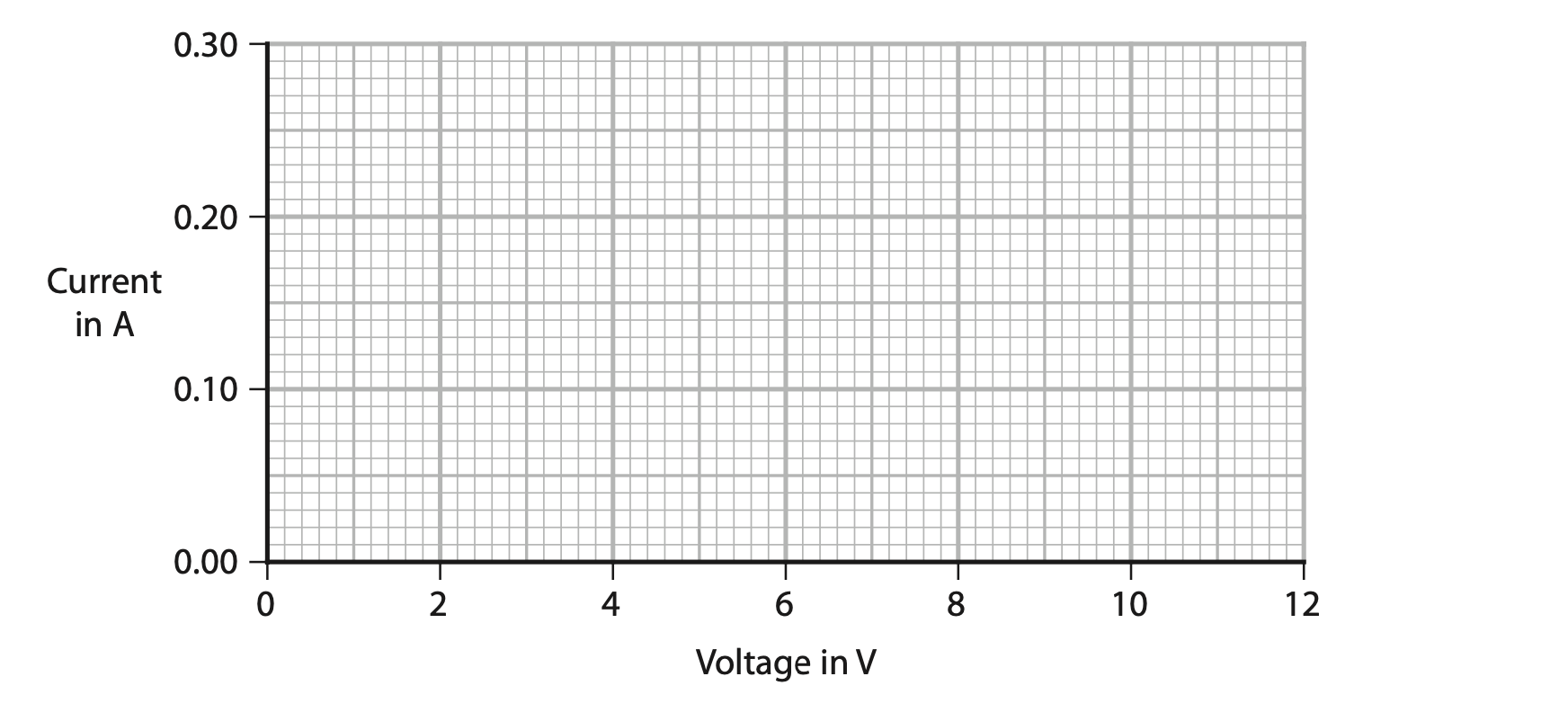
(ii) The student repeats their investigation with a 120 Ω resistor.
Explain how a current–voltage graph for a 120 Ω resistor compares with the current–voltage graph for the 60 Ω resistor. (3)
(Total for Question 6 = 14 marks)
June 23 Paper 2P Q6
6 The National Grid is used in the United Kingdom for the large-scale transmission of electricity. The photograph shows solar panels connected to the National Grid.
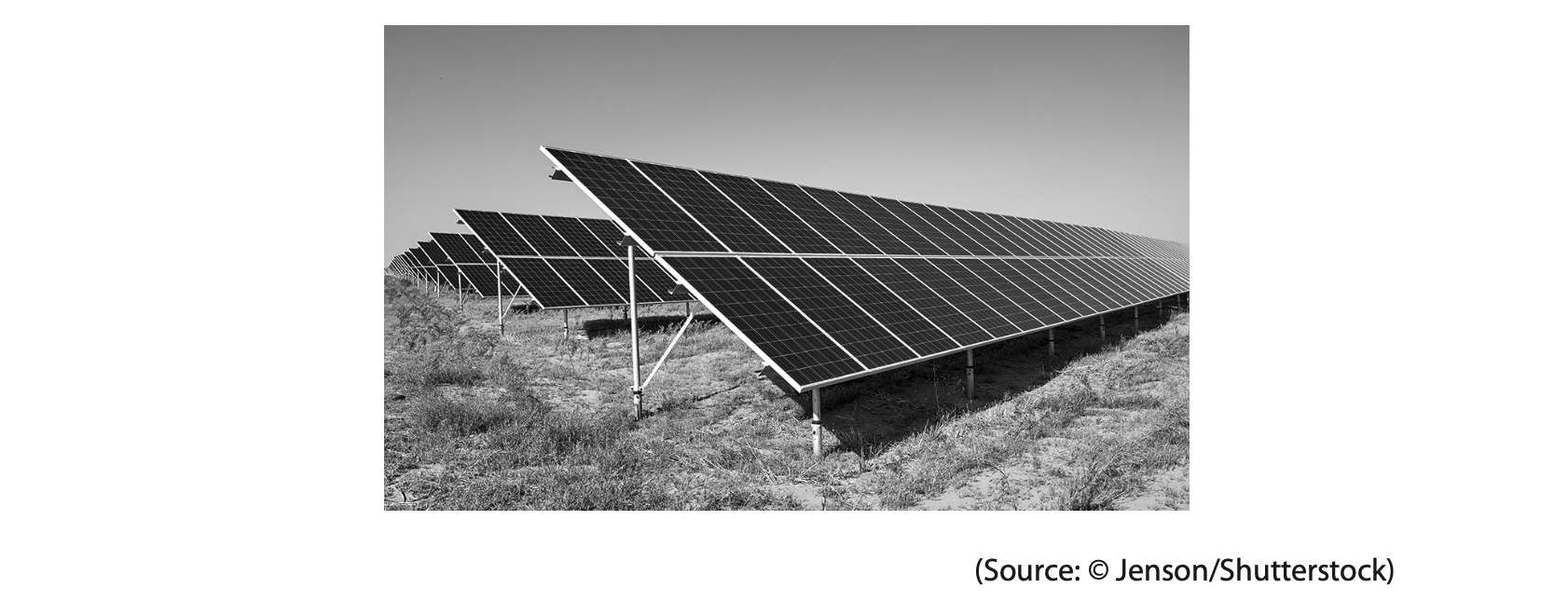
(a) Solar panels provide direct current to a device that outputs an alternating current so that the energy from the solar panels can be supplied to the National Grid.
(i) Explain why a step-up transformer is used to supply the National Grid. (2)
(ii) This is the label on the step-up transformer.
input voltage = 15 kV
output voltage = 340 kV
number of turns on primary coil = 1400
State the formula linking input voltage, output voltage and turns ratio for a transformer. (1)
(iii) Calculate the number of turns on the secondary coil of the step-up transformer. (3)
number of turns = …………………………………………………….
(b) Solar panels produce constant direct current (d.c.)
Explain why a transformer will not work when connected to constant direct current (3)
(Total for Question 6 = 9 marks)
June 23 Paper 2PR Q3
3 A cleaning product is applied to a car using a sponge pad.
The sponge pad is rubbed against the car to apply the cleaning product.
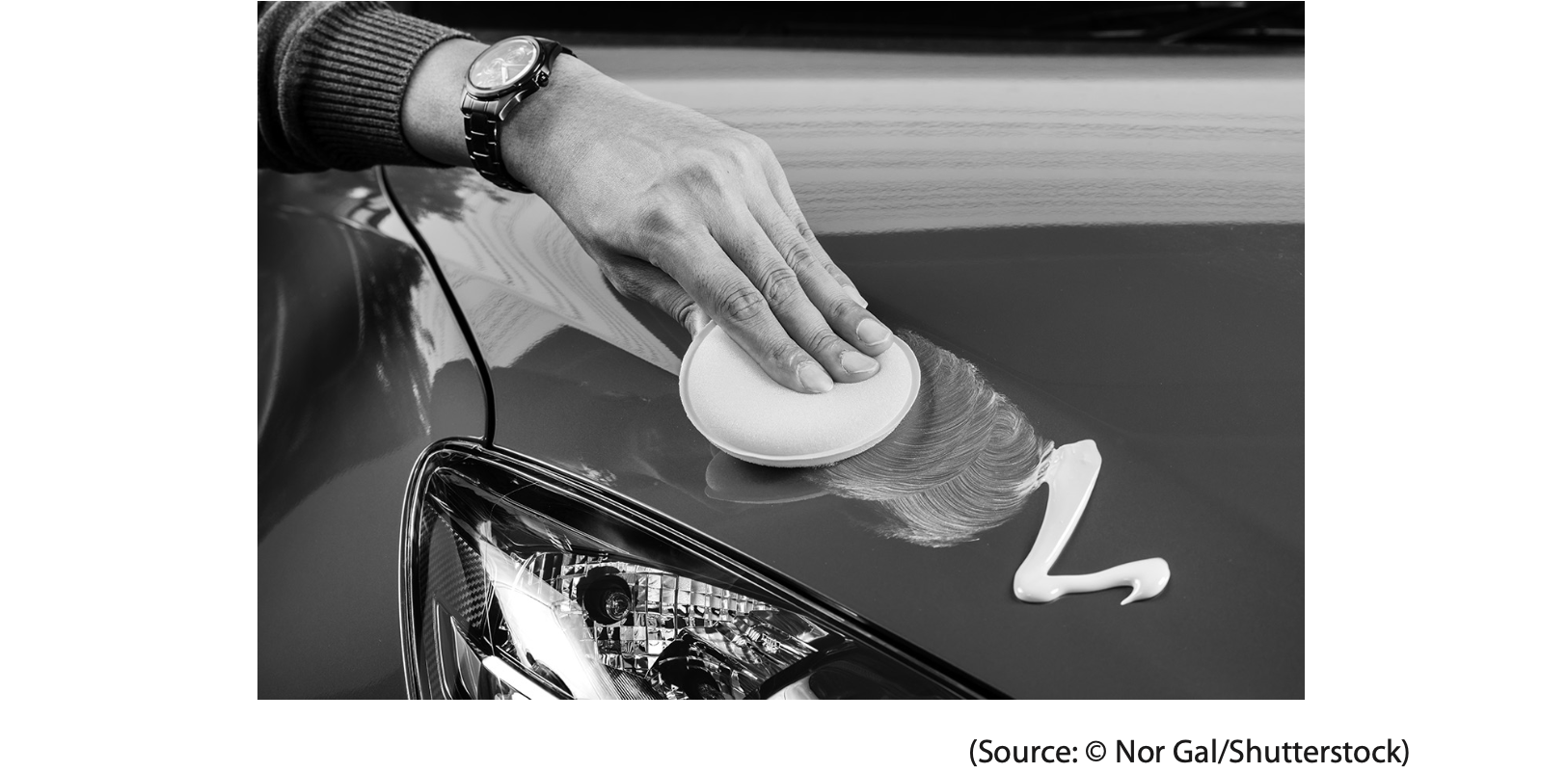
(a) Some parts of the car are made of metal and other parts are made of plastic.
The metal parts of the car are earthed.
Explain why the pad becomes charged when rubbing the plastic parts, but not when rubbing the metal parts. (3)
(b) The sponge pad is held near a metal post that is connected to the ground.
The sponge pad discharges with a small spark through the air to the metal post.
(i) The sponge pad stores 5.0 mJ of energy in its electrostatic store.
The voltage between the sponge pad and the metal post is 6000V.
Calculate the charge transferred by the spark. (3)
charge transferred = …………………………………………………….. C
(ii) The small spark between the sponge pad and the metal post demonstrates that the sponge pad is charged.
Describe a different experiment that could demonstrate that the sponge pad is charged.
You may draw a diagram to support your answer. (2)
(Total for Question 3 = 8 marks)
November 2023 Paper 1P Q2
2 The diagram shows four graphs, P, Q, R and S. Each graph shows a different relationship between current and time.

The table gives descriptions of the relationships between current and time shown by graphs P, Q, R and S.
Complete the table by giving the correct graph for each description.
| Description | Graph |
| current directly proportional to time | |
| current increasing at a decreasing rate | |
| current has a linear relationship to time but is not directly proportional | |
| current decreasing at a decreasing rate |
(Total for Question 2 = 4 marks)
November 2023 Paper 1P Q4
4 This question is about a filament lamp.
(a) Which of these is the correct circuit symbol for a filament lamp? (1)
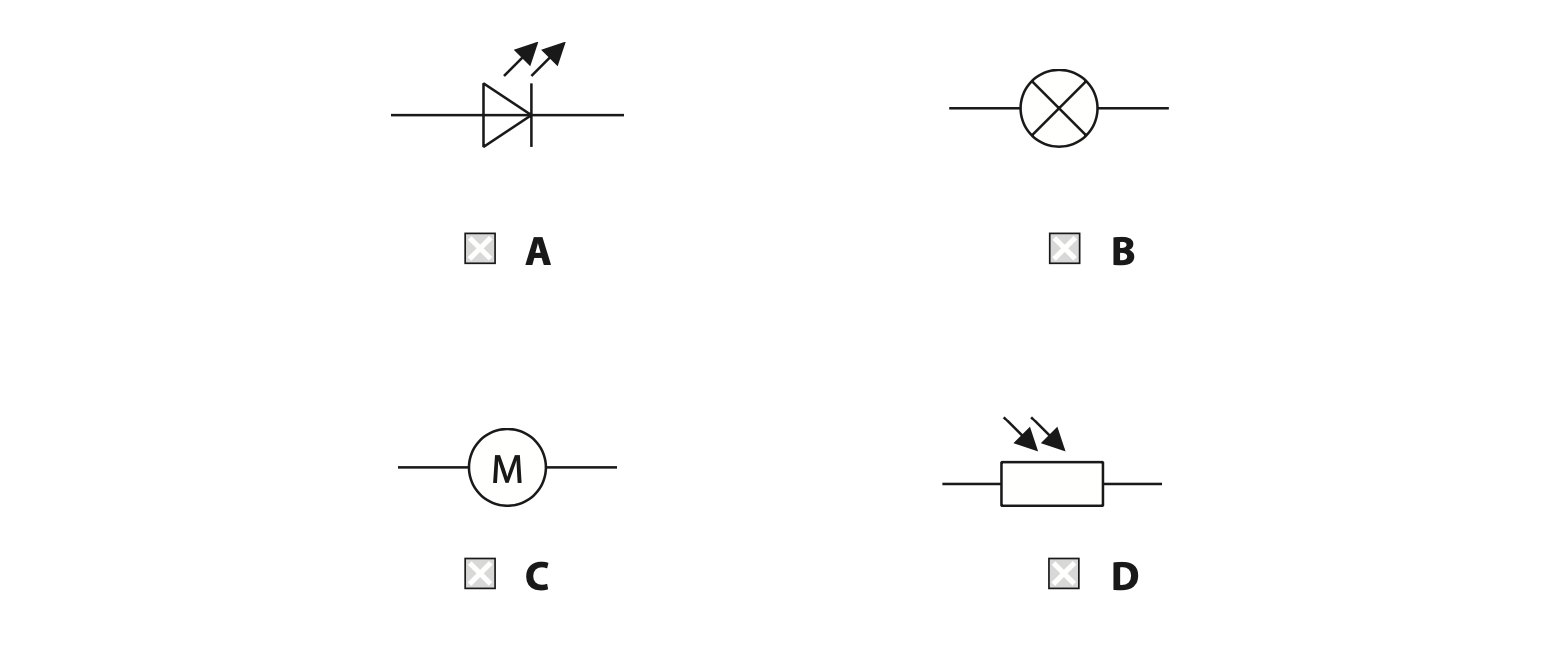
(b) The filament lamp emits visible light.
The table gives some statements about visible light.
Place ticks (✓) in the boxes to show which statements are correct for visible light. (2)
| Statements | Correct (✓) |
| visible light is a longitudinal wave | |
| visible light transfers energy | |
| visible light transfers matter | |
| visible light has a longer wavelength than x-rays | |
| visible light travels faster in water than in air |
(c) The diagram shows a ray of light from the filament lamp incident on the reflective side of a curved mirror.
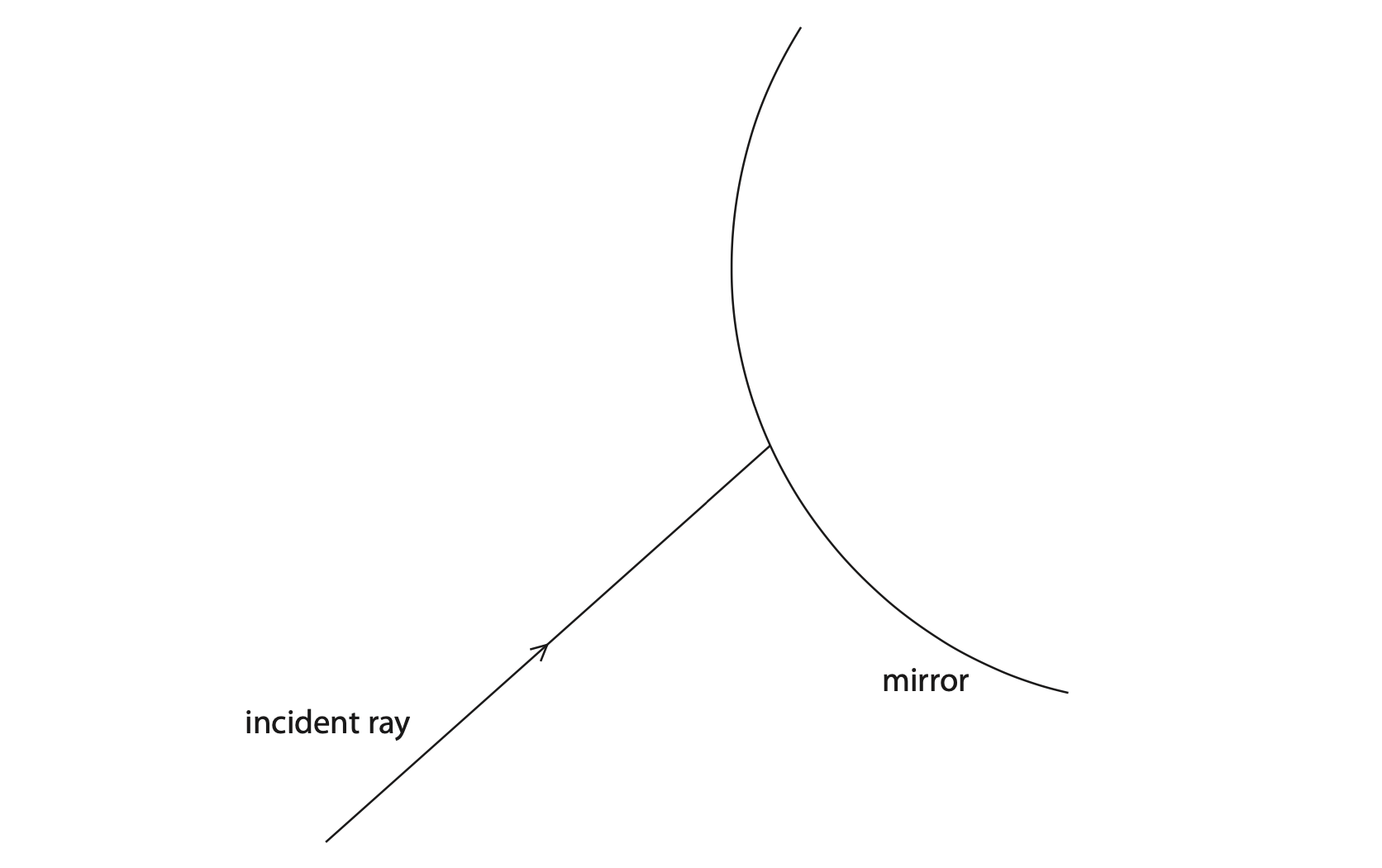
Complete the diagram by drawing
(i) the normal line where the ray is incident on the mirror. (1)
(ii) the reflected ray of light. (2)
(d) The filament lamp is connected in a circuit with a switch and a battery of three cells.

(i) When the switch is on, the filament lamp transfers 120 J of energy in a time of 3.0 minutes.
Each cell has a voltage of 1.5V.
Calculate the current in the filament lamp. (3)
current = …………………………………………………….. A
(ii) A small plotting compass is placed near the wires in the circuit.
When the switch is turned on, the compass needle moves to a new position. Give a reason why the compass needle moves. (1)
(Total for Question 4 = 10 marks)
November 2023 Paper 1P Q10
10 This question is about electrical resistors.
(a) Diagram 1 shows a 13 kΩ resistor connected to a 5.8 V battery.
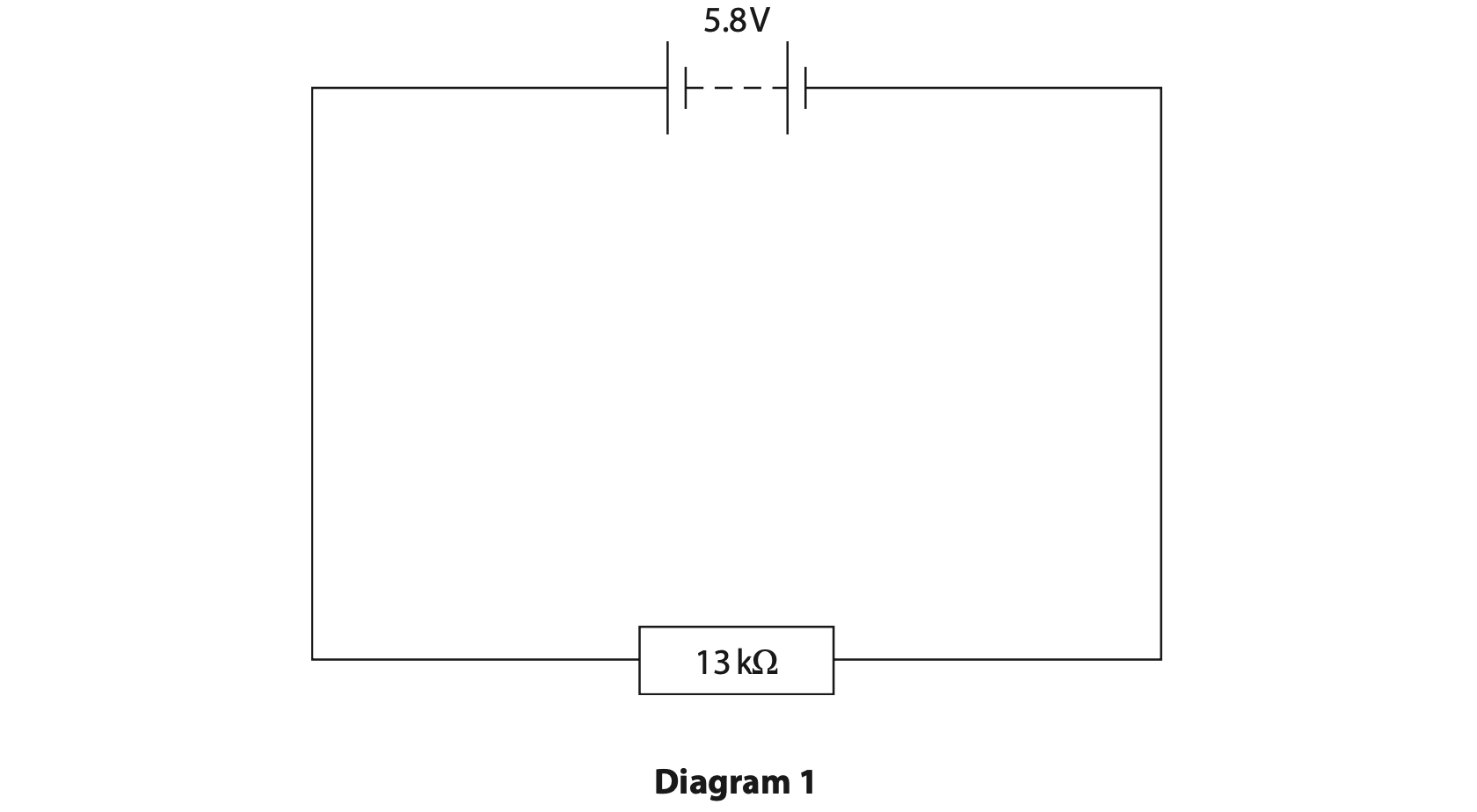
(i) State the formula linking voltage, current and resistance. (1)
(ii) Calculate the current in the resistor. (3)
current = …………………………………………………….. A
(b) Diagram 2 shows a 200 Ω resistor connected in parallel with a 13 kΩ resistor.
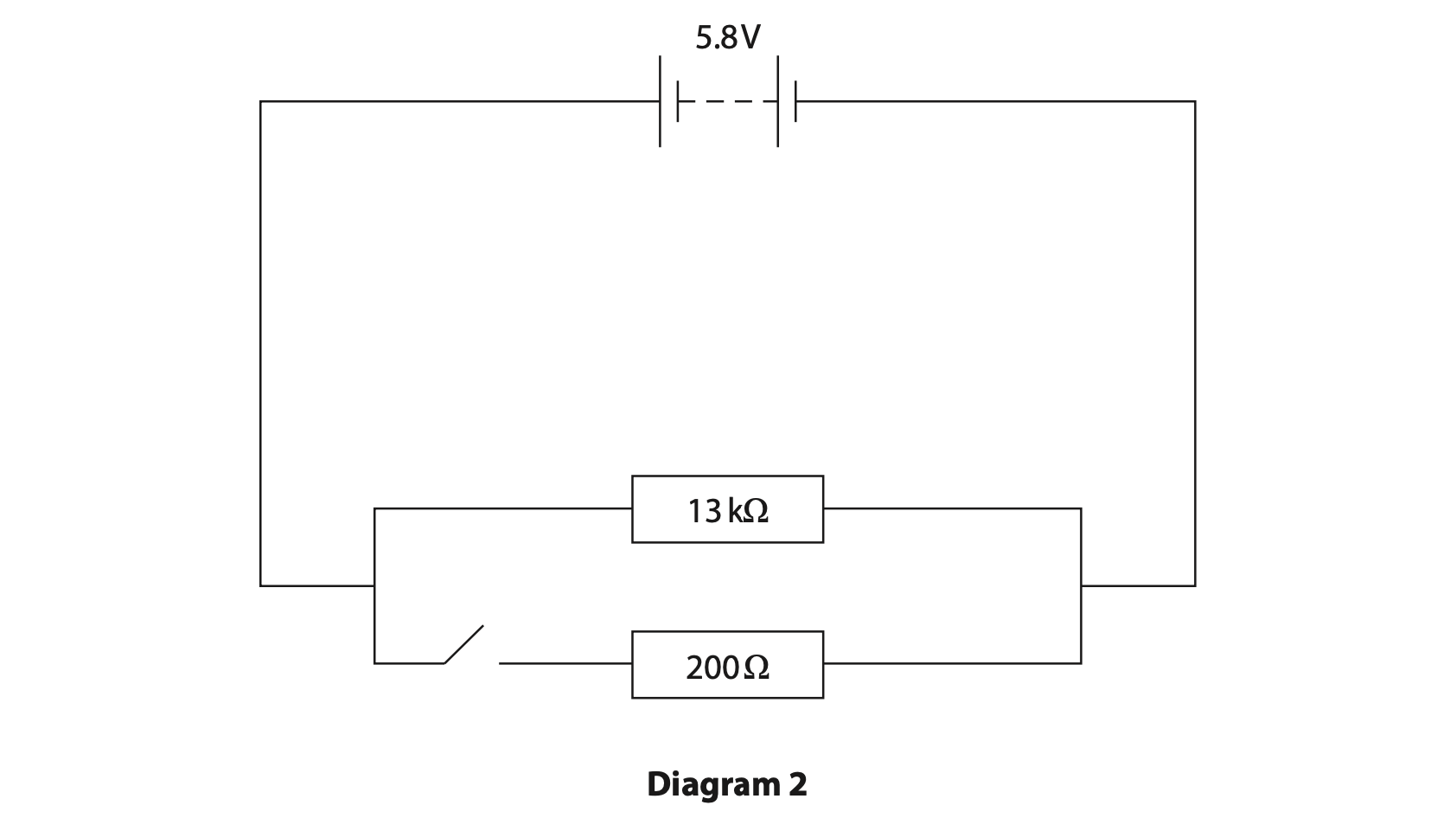
(i) Complete the circuit diagram by adding a suitable meter to diagram 2 to measure the current in the 13 kΩ resistor. (1)
(ii) The switch in the circuit is closed. (5)
Explain what happens to the current in the 13 kΩ resistor and the current in the battery.
13 kΩ resistor:
Battery:
(Total for Question 10 = 10 marks)









